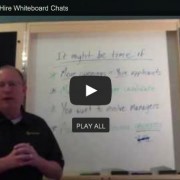Mid-Year Performance Reviews
Human Resources professionals and managers are well-versed on the annual performance evaluation process, but they may have challenges including another integral piece of the employee review process: mid-year performance reviews. Both mid-year and annual reviews are essential to the growth and development of the employee which impacts the company’s profitability. It is crucial to have a plan in place on how, when and why to conduct mid-year performance reviews. Here’s how to make it simpler…
Performance Review Timing
Typically, annual performance evaluations are once a year. These can be on or near the employee’s workiversary or at the end of the calendar or fiscal year. The focus of performance evaluations tends to be more reactive than proactive. Reflecting on the past year’s successes and challenges. Managers communicate the employee’s goals as obtained or unattained with the inability to modify the goals established at the beginning of the year.
When managers conduct mid-year performance evaluations to reevaluate and refine goals, they can save time and boost profit and productivity for the second half of the year. Mid-year performance evaluations are proactive efforts. Examining what is and is not working and strategize how to achieve established goals by the end of the year. When managers complete mid-year performance evaluations, they show their commitment to their team members with actions to devise strategies that support the employee and the team in their efforts to achieve end-of-the year goals.
Why Mid-Year Performance Reviews?
Mid-year performance reviews do not replace the need for managers to have ongoing communication and check-ins with employees on a regular basis. Open, frequent check-ins are part of employee accountability to provide essential, immediate knowledge on the direction of current projects. Communicate the benefits of mid-year reviews to employees so they welcome the conversation instead of being apprehensive about it. Mid-year reviews serve as a “temperature check” to determine the employee’s overall satisfaction in their role. As well as help chart a map towards meeting the remaining end of the year employee performance goals.
When managers conduct mid-year performance reviews with their teams, it provides an opportunity to ensure the team is aligned with the company’s goals, mission and vision and promote employee engagement. Open dialogue in a mid-year performance review gives the employee and manager insight into what they are feeling. It gives an opportunity for the manager and employee to work together and brainstorm solutions to reduce barriers preventing the employee from performing and being the best employee they can be.
How to Prepare
Mid-year performance reviews require organization and analysis. Managers should take a few days to prepare for the meeting with the employee after reviewing performance data, KPIs and productivity measures. List strengths of the employee’s performance to share early in the conversation. Thoughtfully reflect on the areas where the employee needs development, and ask the employee what they need from the company to meet established goals. Always give specific examples of tasks that went well or could have been improved for reinforcement.
Be aware of trends or situations that might be affecting employees’ performance. Higher inflation costs, staffing shortages, and supply chain issues impact the company as a whole, but effects from those global influences inevitably trickle down to employees. Higher inflation costs make the profit margin shrink so employees have less room for error when spending or making goods. Staffing shortages can reduce the capacity of the most productive employees when they are faced with covering for additional role(s) while performing their own. Delays in acquiring essential items for operation can delay the final product. The global market is truly an intricate puzzle with factors and people that carefully fit into the whole picture to make the prize product.
Conducting The Performance Reviews
Conduct the mid-year review in a comfortable setting if possible. Go to lunch together, even if the employee is remote. Order food delivery or reimburse the remote employee for the working lunch session. If providing lunch is not feasible due to team size or budgetary constraints, have the session in a neutral meeting room for onsite and hybrid employees to mitigate concerns of “being called into the boss’s office”. For remote-only employees, managers and employees should schedule a time that works on the shared office calendar. Take into account differing time zones, time off and other related factors. Conduct remote mid-year reviews with the camera on to make it more personal.
Setting Goals
Use the mid-year review conversation with the employee to reexamine existing goals. Are existing goals ascertainable? If meeting certain goals is in question, brainstorm why and how those goals can be attainable. Are there goals that need to be modified or eliminated due to shifts in responsibilities? If certain goals have been attained, what new goals can be created? Listen to the employee’s thoughts. Because the employee is in the depth and breadth of their role, they might see challenges and opportunities that the manager does not. Managers must listen to the employee’s observations and concerns. Be candid with the employee as to what can and cannot readily be changed.
When collaborating with the employee, listen to their ideas and concerns. When goals need to be set or realigned, be SMART about goal setting.
S
Keep the goal specific. Too many facets of one goal can be daunting and overwhelming for an employee to understand and achieve. When a goal has multiple layers, it can be difficult to determine if or when it was completed.
M
Define how the goal will be measured. Whether a goal is quantitative, qualitative, or a mix of both, parameters must be established. Both the employee and the manager must not end the mid-year performance review without confirming understanding of what is being measured and how it will be measured.
A
All goals must be attainable in you performance review. Goals must be feasible for the employee to achieve. Management must ensure that all employees have applicable resources available for employees’ use. If goals are unreasonable or unattainable, employees will feel the frustration of what could be viewed as their inability to meet goals. In these situations, often job loss of some format occurs – voluntary or involuntary. Companies would prefer not to terminate employees unless absolutely necessary because of the cost and time to replace the terminated employees. Employees would prefer to stay at a company if they feel they are supported professionally and personally, and if those needs are not met, they will find work with a different company. Companies lose with turnover so managers should be a catalyst for their employees’ success.
R
Make the goal relevant to the employee and the company. Ensure that goals for the employee intertwine with the employee’s professional development and the company’s goals for productivity. When an employee uses their professional knowledge and skills to achieve company goals, it delivers personal fulfillment for the employee while boosting the company’s development.
T
Employees need to know when goals are due so make them time-bound. Goals without a due date can be overlooked or ignored by employees and potentially their managers. Establishing a timeline of due dates to share goal updates, progress or stagnation statuses, and, ultimately, the final results provide employees with clear expectations of what is expected by when. Time-bound goals hold both the employee and manager accountable for their deliverables.
Conclusion
A company’s success is a marathon and not a sprint. Mid-year performance reviews provide the opportunity for managers and employees to collaborate on what is needed to successfully cross the finish line. Creating SMART goals will help managers and employees stay on their path to enhanced productivity as both entities know what is expected and when. Use the time after the mid-year review to keep communication flowing. Check-ins to determine how employees are proceeding on their paths can help. Strategize, as needed, if established goals need modification. When management has open communication, not to hear but listen to employees, the emphasis truly is on the team.









 15% OFF FULL-SERVICE HIRING • APPLICANT TRACKING SOFTWARE • ONBOARDING SOFTWARE
15% OFF FULL-SERVICE HIRING • APPLICANT TRACKING SOFTWARE • ONBOARDING SOFTWARE